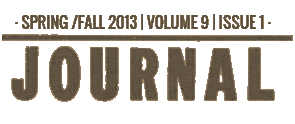· SPRING /FALL 2013 | VOLUME 9 | ISSUE 1 ·
Rougarou, an online literary journal.
Circe.
By Nicelle Davis. (Lowbrow Press, 2011. 91 pages, $13.00). ISBN 978-0-9829-5534-5
Reimagining mythical figures in poetry is nothing new. However, The Odyssey’s Circe is an underexplored figure, which gives Nicelle Davis room to play with and complicate Circe and others: sirens, mermaids, and even Odysseus himself. Davis develops a relationship between each throughout the collection of poems, which takes place after Odysseus has left the island
Most of the collection’s poems are written in Circe’s voice. Many poems about Circe herself, such as “Circe Wakes Alone,” show her missing Odysseus, even though she knows he will likely not return. In “Visions of Return from the Crystal Ball of Circe’s Glass Eye,” Circe imagines, “Odysseus exaggerates,” because it is the details of domestic life,
broken cupboards and the scurry of unwanted
feet in walls — not mermaids — that make
walking away from the sea difficult. (25)
In “Dear Odysseus,” she feels incomplete and destroyed by his silence. She asks if he has her story:
Do you have it? If so,
![]() I want it back. I do have a scrap of paper with
your signature — a letter closing with Love. (39)
I want it back. I do have a scrap of paper with
your signature — a letter closing with Love. (39)
The opening poem, “Circe after Odysseus Leaves,” introduces the notion of reading and rereading as a creative act, which reemerges several times:
What used to be a box of love letters
is now a book of spells. I read them.
They make me. Remake me. What
was, will be again. Page one. Again. (20)
Odysseus is writing a cookbook that is less a section of recipes and more how — to guides, in the fourth part of the collection, “The Recipe for Sirens.” In “How to Turn Scream to a Song,” he tells readers to first “hold the creature’s teeth back,” and to “sing into the creature’s new/emptiness until it shines” (54).
Also in the fourth sequence of poems are, “Uses for a Witch’s Eye1.a. Jaw Stopper” and “Uses for a Witch’s Eye1.b. Jaw Stopper,” which play with the myth of the Stygian witches. Each addresses in second person a would-be witch, working alone, who must lose her own eye to complete a spell. The first poem in the sequence then reveals “you” have an eye in your hand, “ready to feed your singing/ want to Sirens” (55). Circe’s lineage will continue with a new witch to appease the Sirens.
The notion of continuing myths also has a continuing lineage, such as Rachel Zucker’s Eating in the Underworld, which reconsiders Persephone, and Stephen Dunn’s poems about Sisyphus. In the wake of so many others attempting it, writing about myth is a challenge. But Davis’s hints of the contemporary world, in poems like “The Lawsuit,” “Dear Odysseus,” and “Eliminating Your Creature Issues,” manage to find something new to say about Circe, Odysseus, and Greek Mythology, which is no small thing.
MARK ALLEN JENKINS
University of Texas at Dallas







